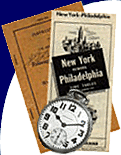

| home | articles | briefs | classifieds | flimsies | interchange |
 |
 |
||||||
|
|||||||
 |
RyPN Briefs June 12, 2006 previous brief ~ return to briefs index ~ next brief Book Review: Biography of the Memphis and Charleston Railroad by Paul Harncourt, revised edition, paperback, 231 pages plus appendices, Outskirts Press, Inc. 2005, $16.95 US Paul Harncourt is a pseudonym for Dan Dobravolsky, who spent five years poring through archives relating to the history of this railroad from its conception in 1829, through its eventual corporate death by inclusion into the Southern Railway System in 1897. First, I gotta say, Wow! I have seldom seen such a compilation of historic documentation relating to one very narrow subject in a history before. It reads more like a term paper than a biography. The majority of the book is in fact copied from historic documents, with a few sentences from the author used to set the context for them, or tie them together. The opening chapter provides a brief history of railroading, all in 6 pages. Thence follows a capsulated description of the life of the railroad in three distinct phases, each of which is explored in detail in subsequent chapters. Appendices are mostly locomotive rosters from various points in time. The several political and economic challenges in chartering and building the railroad take up about a third of the book. The majority of the remainder relates to the many various travails it encountered with plenty of destruction caused by both sides in our Civil War. The Reconstruction Era and its challenges take up most of the remaining pages, with very little included about the last couple decades of the railroads operations before its inclusion into the Southern Railway System. I was struck in particular by the voluminous correspondence included from both the Union and Confederate forces officers, which graphically illustrate the strategic importance of railroads and their use in the first modern war, in which railroads allowed war to progress at faster than horseback speeds. There's a lot of very good information for the Civil War historian, whether a railroad historian or not. There is also a great deal of information about how railroads were chartered and built in their earliest days. As a practical railroader, I was very drawn towards the Sam Tate/reconstruction era documentation detailing how the railroad was resuscitated antebellum. I have not seen the post-war situation of the Southern railroads explained as clearly elsewhere. The book does have some problems, however. The author doesn't seem to have a defined audience in mind, and either assumes we know too much or nothing about Civil War or railroading history, or academic research technicalities. Even regional geography is assumed, both modern and historic - the inclusion of a few maps would have made many of the site references in the historic texts meaningful. He refers to events known to very few as if they ought to be common knowledge, such as the "Holly Springs Affair." Most of these references are explained further along in the text somewhere, but leave the reader in limbo until reaching that point. The text also suffers from many typographical, proofreading and contextual errors, some of which provide unintentional humor, for example: "A Mr. Friedrichs invented a railway system to serve a silver mine in Germany sometime before 1811, including a locomotive engine with a 4 wheeled cart. His father is described as 'a MINOR in the region'." Can you imagine how precocious an inventor he must have been, given he couldn't have been much more than a toddler if his father was under 18 at the time? Also, "In 1813, a Mr. Blackitt of Wylam Colliery discovered simple adhesion would provide adequate traction for a locomotive. His one-cylinder locomotive 'moved STEADILY, BY JERKS'."
Huh? Isn't steady motion the opposite of jerky motion? Or perhaps he meant that the engine crew were obnoxious oafs........... And these are just a couple examples from the first 3 pages. In general, apart from the damage done by an incompetent proofreader and over reliance on contextually insensitive spell-check software, there is a lot of good colorful history to be found in this book. This railroad had the disadvantage of having been built through interesting country in an interesting time, to paraphrase the Chinese curse, which makes for an interesting story to tell. The publishers can be reached at www.OutskirtsPress.com. |
|
Copyright © 1998 thru 2024, all rights reserved, contents may not be used without permission. |